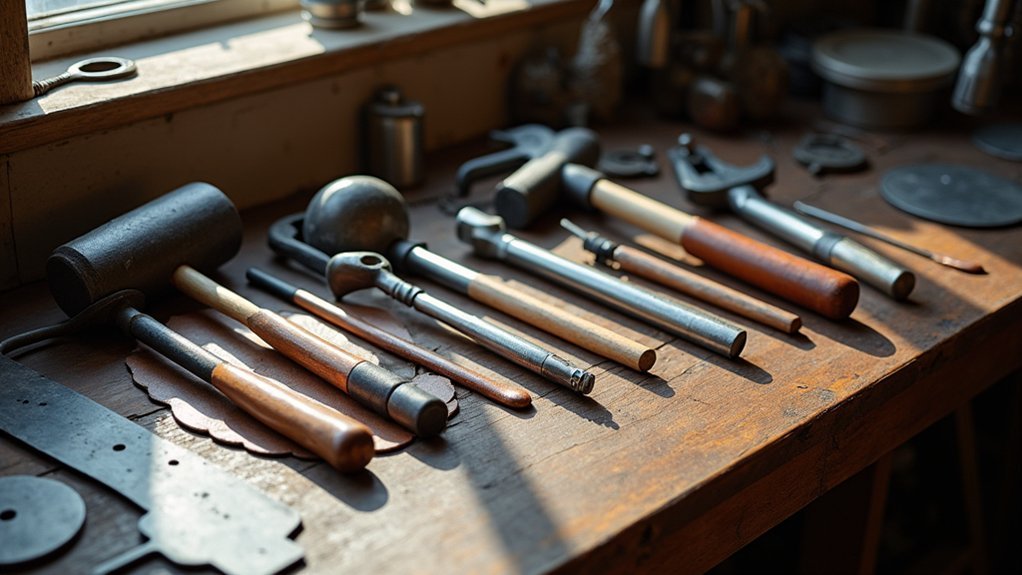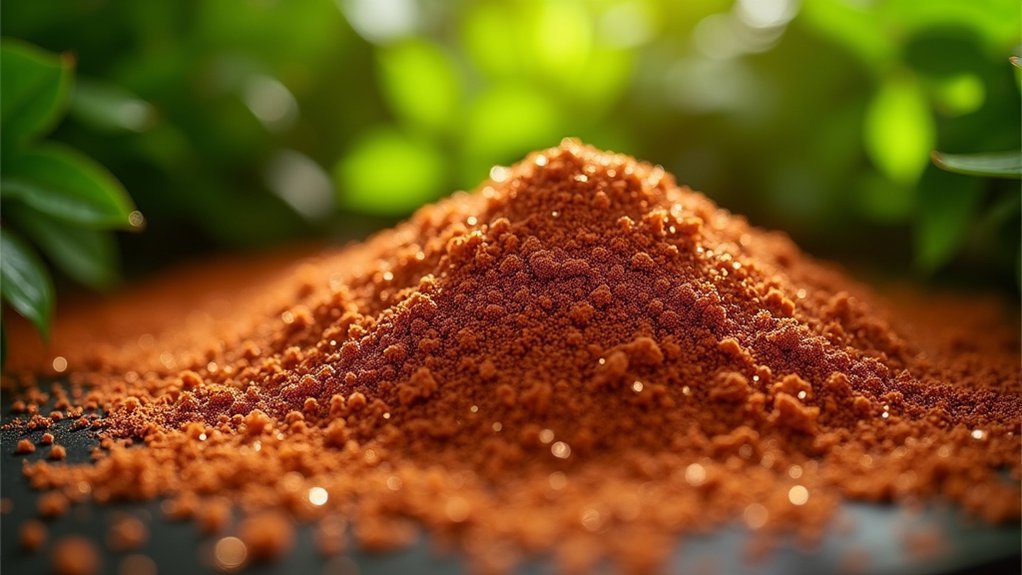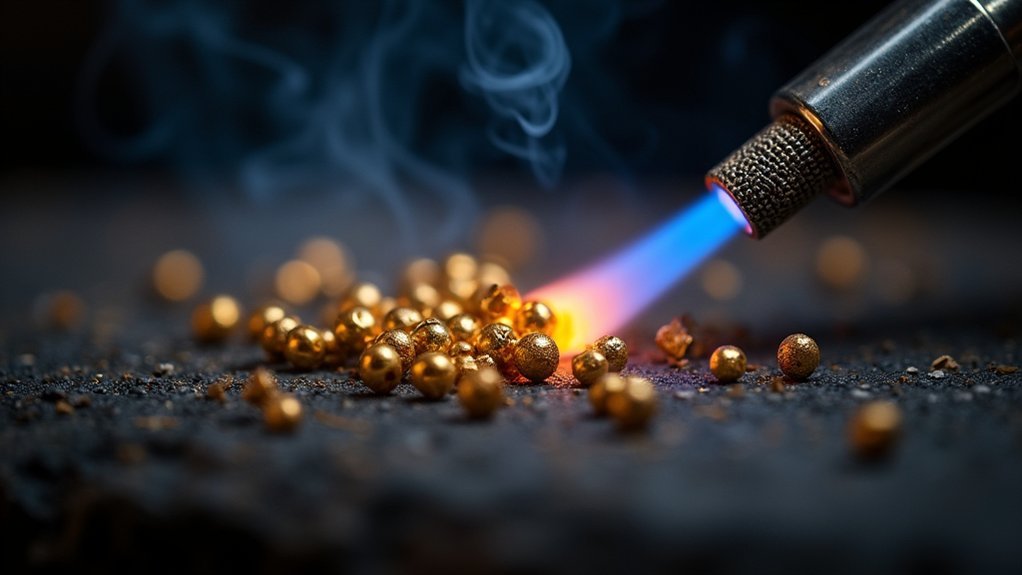You’re about to commence a creative journey that connects you to ancient craft traditions while expressing your unique artistic vision. As 2025 approaches, the metalsmithing world offers innovative starter collections that balance traditional techniques with modern efficiency. Whether you’re drawn to jewelry making, decorative objects, or functional art pieces, the right tools will determine your early success and enjoyment. What five essential collections should you prioritize before striking your first hammer or lighting your first torch?
8 Pcs Crucibles for Melting Metal Kit with Tongs
For the aspiring metalsmith, the 8 Pcs Crucibles for Melting Metal Kit with Tongs represents an essential foundation for your creative journey. This versatile set includes six ceramic crucibles in two sizes (250g and 100g) plus two durable tongs.
You’ll appreciate the premium construction that withstands temperatures up to 3272°F, making it perfect for melting gold, silver, brass, and copper. The tapered design with pouring spouts reduces waste while ensuring even heating.
For best results, preheat your crucibles and apply borax glaze before first use. This simple step enhances durability and heat resistance, extending the life of your metalworking essentials.
Best For: Jewelry makers, metal casting enthusiasts, and hobbyists looking for a comprehensive set of crucibles that can withstand high temperatures for melting various metals including gold, silver, brass, and copper.
Pros:
- Includes multiple crucible sizes (250g and 100g) to accommodate different project needs
- High temperature resistance up to 3272°F (1800°C) makes it suitable for melting various metals
- Tapered design with pouring spouts reduces waste and spillage during metal casting
Cons:
- Requires preheating and borax glazing before first use for optimal performance
- May have slight size variations due to manual measurement
- Limited customer feedback with only 3 ratings (3.9/5 stars)
Metal DIY Model Kit Tool Set (10 Pieces) for 3D Puzzles
Precision metalwork becomes accessible to every skill level with this extensive 10-piece toolset from Worldity. You’ll find everything needed for intricate 3D metal puzzles: three specialized pliers, two bending tools, and five cylindrical cone aids.
Crafted from premium stainless steel, these acid and corrosion-resistant tools are lightweight yet durable. The hardened pliers maintain sharpness through countless projects.
At just 8.4 ounces, you’ll easily transport this compact kit anywhere. Users particularly praise the long round stock piece for its versatility in shaping metal components. With a 360-day warranty backing your purchase, you’re investing in reliable craftsmanship.
Best For: DIY enthusiasts and hobbyists working on 3D metal puzzles who need precision tools for bending, shaping, and manipulating small metal pieces.
Pros:
- Comprehensive 10-piece set includes three specialized pliers and seven bending tools to handle various metalworking needs
- Made from premium stainless steel that resists acid and corrosion, ensuring long-term durability
- Lightweight design (8.4 ounces) and compact size make it highly portable and easy to store
Cons:
- Missing additional helpful tools like tweezers and curved needle-nose pliers that would enhance functionality
- Limited instruction on proper tool usage, potentially challenging for complete beginners
- Tools may be too small for larger-scale metalworking projects or those with larger hands
ImpressArt Mini Crystal Setter Metal Stamping Punches Kit
Adding a touch of sparkle to your metalwork designs becomes effortless with the ImpressArt Mini Crystal Setter Metal Stamping Punches Kit. This compact set includes everything you’ll need: 150 mixed metallic crystals, a 1.5mm metal stamping punch, and three crystal punches (1.8mm, 2.5mm, and 4mm).
You’ll also receive 216 birthstone crystals in 12 colors. Simply hold the setter flush against your soft metal (works with aluminum, copper, brass, silver, and gold), strike with medium force, and secure crystals using adhesive. Don’t forget to purchase G-S Hypo Cement separately for best results on your bespoke jewelry pieces.
Best For: Beginner to intermediate jewelry makers and metal stamping enthusiasts looking to add decorative crystals to soft metal projects without needing specialized equipment.
Pros:
- Complete starter kit with multiple crystal sizes (1.8mm, 2.5mm, 4mm) and an assortment of 366 crystals in various colors including birthstones
- Compatible with a wide range of soft metals including aluminum, copper, brass, silver, and gold
- Simple technique that requires minimal training and produces professional-looking embellishments
Cons:
- Adhesive (G-S Hypo Cement) must be purchased separately despite being essential for completing projects
- Some users report quality issues with punch tools breaking during use
- Limited to working on soft metals only; not suitable for harder materials or thick metal pieces
RotoMetals Low-Melting Point 158-190F Bismuth Based Alloy Ingot
Gunsmiths and metal casting enthusiasts will find the RotoMetals Bismuth-Based Alloy Ingot an essential addition to their toolkit. This USA-made 1-pound ingot melts at just 158-190°F, making it perfect for chamber casting, toy soldier molding, and creating foundry patterns.
You’ll appreciate its versatility—melt it with a stove, oven, or even a good lighter. For firearm headspace measurements, especially in Mauser Gewehr 98 chambers, simply oil the chamber, heat the receiver to 120°F, pour the molten alloy, and remove promptly after solidification. This affordable alternative to Cerrosafe offers identical composition at half the price.
Best For: Gunsmiths, firearms enthusiasts, and metal casting hobbyists seeking an affordable, low-temperature alloy for chamber casting, pattern making, and precision mold creation.
Pros:
- Contains the same composition as Cerrosafe (42.5% Bismuth, 8.5% Cadmium, 37.7% Lead, 11.3% Tin) but at approximately half the price
- Extremely low melting point (158-190°F) allows for easy melting with common heat sources without damaging firearm components
- Contracts while cooling and expands during crystallization, creating precise chamber measurements and allowing for easy removal of castings
Cons:
- No instructions included with the product (must visit RotoMetals website for proper usage guidelines)
- May stick to surfaces if not removed promptly after solidification, requiring careful timing
- Requires practice, preparation, and patience to master the optimal process for chamber casting
RotoMetals Pewter Alloy R-92 Casting Ingot
The RotoMetals Pewter Alloy R-92 Casting Ingot offers beginners and experienced metalworkers a lead-free composition that’s perfect for creating everything from jewelry to decorative pieces.
With 92% tin and 8% antimony, this alloy melts at a manageable 466°F. You’ll appreciate its versatility when casting in plaster, sand, or rubber molds. Each one-pound ingot measures approximately 1 x 2 x 1 inches, making them convenient to store and use.
Crafters consistently praise the alloy’s minimal dross and excellent flow properties. You’ll find it ideal for holiday gift-making, awards, and accessories. Its reliability and quick melting time make this pewter a staple for your metalsmithing toolkit.
Best For: Beginner and experienced metalworkers seeking a lead-free pewter alloy with a low melting point for creating jewelry, decorative items, awards, and gift pieces.
Pros:
- Composed of 92% tin and 8% antimony with no lead or copper, making it safe for handling and a variety of projects
- Low melting temperature (466°F) makes it accessible for home crafters using basic equipment
- Versatile for multiple casting methods including plaster of Paris, sand, and rubber molds with minimal dross formation
Cons:
- Some inconsistency in ingot sizing, with customers occasionally receiving 2-pound bars instead of the expected 1-pound ingots
- Limited color options as it only comes in the standard pewter finish
- May require additional equipment purchase for proper melting and casting for first-time metalworkers
Factors to Consider When Choosing Metalsmithing Starter Collections for New Artisans
When selecting your first metalsmithing collection, you’ll need to balance the melting temperatures of your chosen metals with your available equipment capabilities. Consider investing in higher-quality tools that will last rather than cheaper options that might need replacement, while ensuring all materials in your starter kit work compatibly together. Your initial projects should match your skill level, so choose collections that allow for simple techniques before progressing to more complex metalworking challenges.
Subheading Discussion Points for “Factors to Consider When Choosing Metalsmithing Starter Collections for New Artisans”
Selecting the right metalsmithing starter collection can dramatically impact your initial experience and long-term success in this craft. Look for versatile toolsets that allow you to explore various techniques including stamping, casting, and shaping metal for different creative projects.
Prioritize durable, corrosion-resistant materials that can withstand high temperatures. Don’t compromise on safety gear—protective equipment should be included in any quality starter kit. Consider how portable the collection is if you’ll be working in multiple locations.
Before purchasing, check user reviews from fellow beginners to verify the tools’ reliability and effectiveness. The weight of your tools matters too—lighter options can prevent fatigue during lengthy projects. Your starter collection should balance quality, versatility, safety, and mobility to support your artisanal journey.
Melting Temperature Requirements
Understanding melting temperatures represents a critical factor in choosing your first metalsmithing collection, as each metal demands specific heat thresholds for successful manipulation. Your tools must be capable of handling the heat range of metals you’ll work with.
For beginners exploring bismuth-based alloys (158-190°F), simple heating elements suffice, while pewter work (466°F) requires more robust equipment. If you’re planning to work with precious metals like silver (1761°F) or gold (1962°F), you’ll need professional-grade crucibles, tongs, and heat-resistant surfaces.
Assess your project goals before investing. If you’ll stick with low-temperature metals, a basic kit will serve you well. However, if you’re ambitious about working across multiple metal types, invest in versatile equipment that can safely handle higher temperatures.
Tool Quality vs. Price
Three essential factors separate premium metalsmithing tools from budget alternatives: durability, precision, and long-term value. When you’re building your starter collection, prioritizing quality over initial cost will save you frustration and money in the long run.
Higher-quality tools with stainless steel pliers and advanced ceramic crucibles reduce the risk of failure during essential tasks. They’re also typically designed with superior ergonomics, improving your comfort during long working sessions and enabling more precise results.
While affordable sets might seem appealing, they often compromise on acid and corrosion resistance—properties that dramatically extend tool lifespan. For specialized techniques requiring high temperatures, investing in premium equipment becomes even more significant. Remember that well-crafted tools aren’t just expenses; they’re investments in your craftsmanship and artistic growth.
Material Compatibility Range
When establishing your first metalsmithing collection, the compatibility between your tools and various metals becomes vital for artistic exploration. You’ll want to select tools that work effectively with a spectrum of soft metals including aluminum, copper, brass, and silver to maximize your creative possibilities.
Look for collections featuring tools rated for multiple metal types, allowing you to experiment with different alloys and finishes without purchasing separate equipment. Confirm your kit includes materials that can withstand specific melting temperatures—particularly important when working with low-melting-point metals like pewter and bismuth for casting projects.
The most versatile collections offer diverse tools designed specifically for shaping, bending, and cutting different metal forms. Don’t overlook components supporting adhesives and bonding agents, which are essential for securing elements in stamping and jewelry making projects.
Project Complexity Level
Selecting an appropriate metalsmithing starter collection depends largely on the complexity of projects you plan to pursue as you begin your artistic journey. Beginner kits should include tools and materials that align with simpler designs, allowing you to build confidence without unnecessary frustration.
Start with collections geared toward basic techniques like melting, casting, or stamping. These foundational skills will prepare you for more intricate work later. Look for versatile tool sets that support a range of projects—from simple jewelry pieces to small decorative items—so you can experiment as your abilities grow.
Before purchasing, evaluate whether the kit’s components match your ambitions. The tools’ quality and durability matter greatly, as reliable equipment will improve your success rate and extend your collection’s usefulness as you advance.
Safety Features Included
Every worthwhile metalsmithing starter collection prioritizes user protection alongside artistic potential. When selecting your first kit, look for ergonomic handles on tools to prevent strain during extended crafting sessions. The best collections include essential protective gear—safety goggles and heat-resistant gloves—that shield you from sparks, fragments, and high temperatures.
Quality collections come with thorough safety instructions for handling materials, especially those involving metal melting or casting. Verify that tools are crafted from durable, high-quality materials that won’t break unexpectedly during use, potentially causing injury.
Don’t overlook ventilation recommendations—proper airflow is vital when working with substances that release fumes during heating processes. Your creative journey shouldn’t come at the expense of your wellbeing, so invest in collections where safety features complement craftsmanship capabilities.
Storage and Organization
A well-organized metalsmithing kit forms the foundation of efficient craftsmanship. When selecting your starter collection, prioritize options that include thoughtful storage solutions to keep your tools accessible and protected from damage.
Look for compact toolboxes or organizers that offer portability without sacrificing functionality. You’ll appreciate labeled compartments that categorize tools by type or function, helping you quickly locate what you need during intense creative moments. This organization system proves especially valuable as you’re learning to identify different tools.
Consider the durability of your storage solution—it should accommodate heavier tools without tipping and protect metal implements from moisture that causes rust. The best starter collections feature storage that’s designed to grow with your skill level, allowing you to add specialized tools while maintaining organization.
Frequently Asked Questions
What Safety Equipment Is Essential for Beginning Metalworking?
You’ll need safety glasses, heat-resistant gloves, a fire extinguisher, proper ventilation, and a respirator when working with metals. Don’t forget ear protection and an apron to protect against sparks and debris.
How Do I Properly Ventilate My Workspace?
You’ll need proper ventilation with an exhaust fan that pulls fumes outside. Install a dedicated system near your workstation, use portable air purifiers, and consider a fume extractor when soldering or using chemicals.
Can I Practice Metalsmithing in an Apartment?
Yes, you can practice metalsmithing in an apartment with limitations. Focus on small-scale projects, use portable ventilation systems, avoid toxic materials, and check your lease agreement for restrictions on home-based workshops.
How Much Should Beginners Budget for Metalsmithing Supplies?
You’ll need to budget $300-500 for basic metalsmithing supplies. This covers essential tools like files, pliers, a torch, metal sheets, and safety equipment. Start small and expand your collection as you gain experience.
Which Metals Are Easiest for Beginners to Work With?
You’ll find copper and brass most forgiving for beginners. They’re affordable, malleable, and don’t tarnish quickly. Sterling silver is also excellent once you’re comfortable with basic techniques and ready to upgrade.





Leave a Reply